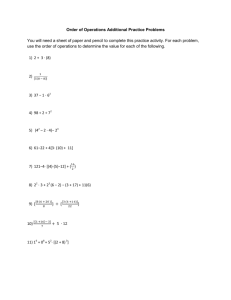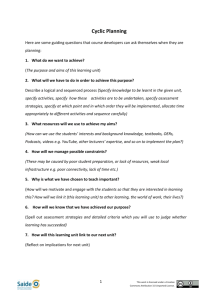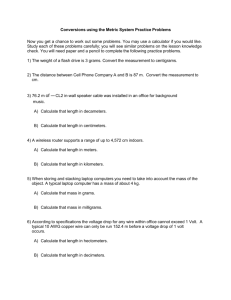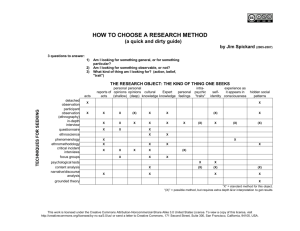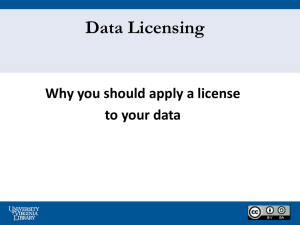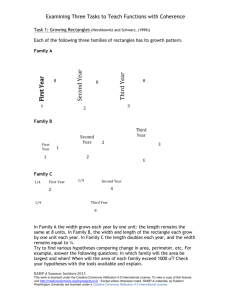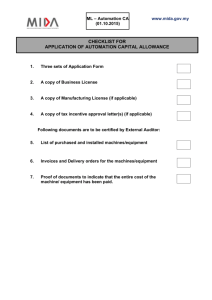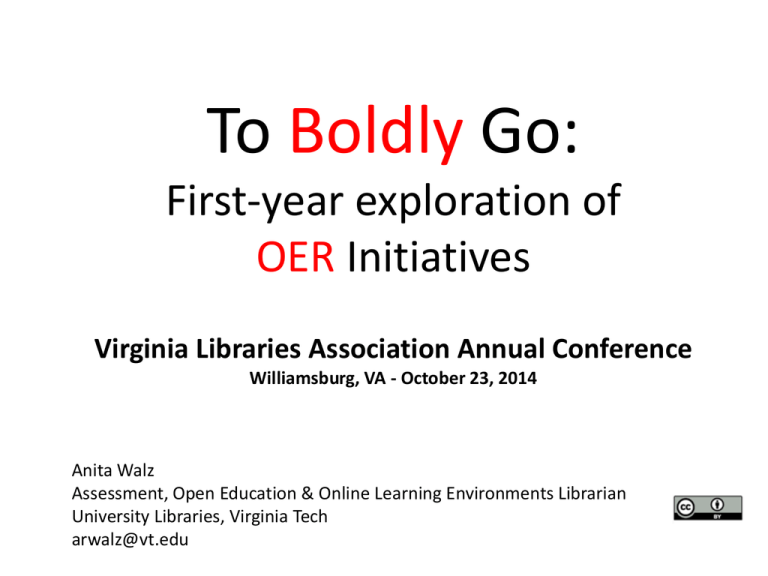
To Boldly Go:
First-year exploration of
OER Initiatives
Virginia
Virginia Libraries Association Annual Conference
Williamsburg, VA - October 23, 2014
Anita Walz
Assessment, Open Education & Online Learning Environments Librarian
University Libraries, Virginia Tech
arwalz@vt.edu
My charge (25%)
• Explore and disseminate information regarding Open Educational
Resources (OER) (to include digital textbooks and multimedia) to the
library community and interested faculty at Virginia Tech.
• Identify current faculty practices
• Survey peer institutions for:
1)
2)
3)
Ways that librarians are providing support and services in this space;
Ways that instructors are currently using open educational
resources and
Uncover any advocacy for OER and their impact on teaching/
learning
• Identify opportunities for the Libraries to lead or partner in
initiatives regarding OERs at VT.
Virginia Tech
~ 3,700+ faculty
29,000 students on campus + some off campus
“Residential Undergraduate Experience”
+ plus online options
Tenure, academic freedom and faculty choice
= Decentralized faculty decision-making
Session Objectives
By the end of this presentation you should be able to:
• Describe the concept of Open Educational Resources
• Articulate rationale for OER
• Summarize existing & potential contributions by libraries
Why Open Educational Resources?
OER have the potential to . . .
• reduce the cost of education for students
• increase student retention (saving institutions $)
• allow innovative pedagogy (which may increase
student achievement)
Why Open Educational Resources?
© 2014, Mark Perry, Scholar at American Enterprise Institute for Public Policy Research. All Rights Reserved. Used with permission.
https://twitter.com/Mark_J_Perry/status/459395162032988160/photo/1
http://www.aei-ideas.org/2012/12/the-college-textbook-bubble-and-how-the-open-educational-resources-movement-is-going-up-against-the-textbook-cartel
Publishers respond with
Rental options
and Custom textbooks
Custom Editions $$ from Wiley, Pearson & McGraw Hill
Software access codes continue to be bundled.
All images are property of their respective owners and may be subject to copyright. Used under “fair use.”
Why Open Educational Resources?
65% of [college] students
surveyed said that they had
decided against buying a
textbook because it was
too expensive.
94% of students who had foregone purchasing a
textbook were concerned that doing so would hurt
their grade in a course.
U.S. PIRG (2014) “Fixing the Broken Textbook Market: How Students Respond to High Textbook Costs and Demand
Alternatives ” http://www.uspirg.org/reports/usp/fixing-broken-textbook-market
© Ezra S F “NCC-1701-D” CC BY
What are
Open Educational
Resources
anyway?
Open Educational Resources . . .
- are teaching, learning, and research resources
- that reside in the public domain or have been
released under an intellectual property license that
permits their free use and re-purposing by others.
- include full courses, course materials, modules,
textbooks, streaming videos, tests, software, and
any other tools, materials, or techniques used to
support access to knowledge."
- Hewlett Foundation
What kind of “open” did you mean?
–
Free (Open Access)
–
Free (Openly licensed)
redistribute, edit, remix/tweak, build upon;
no need to navigate fair use & copyright exemptions
See also: 4Rs http://opencontent.org/blog/archives/1123 and the 5th R http://opencontent.org/blog/archives/3251
Creative Commons License Symbols
6 Creative Commons Licenses
Attribution “CC-BY”
Attribution ShareAlike “CC BY-SA”
Attribution Noncommercial “CC BY-NC”
Attribution NonCommercial ShareAlike “CC BY-NC-SA”
Attribution NoDerivatives “CC BY-ND”
Attribution NonCommercial NoDerivatives “CC BY-NC-ND”
6 Creative Commons Licenses
Attribution “CC-BY”
This license lets others distribute, remix, tweak, and build upon a work, even commercially, as
long as they credit the original author for the original creation. This is the most accommodating
of licenses offered, in terms of what others can do with a work licensed under Attribution.
6 Creative Commons Licenses
Attribution “CC-BY”
This license lets others distribute, remix, tweak, and build upon a work, even commercially, as long as
they credit the original author for the original creation. This is the most accommodating of licenses
offered, in terms of what others can do with a work licensed under Attribution.
Attribution ShareAlike “CC BY-SA”
This license lets others remix, tweak, and build upon a work even for commercial reasons, as long as they
credit the original author and license their new creations under the identical terms. This license is often
compared to open source software licenses. All new works based on a work licensed this way will carry
the same license, so any derivatives will also allow commercial use.
6 Creative Commons Licenses
Attribution “CC-BY”
This license lets others distribute, remix, tweak, and build upon a work, even commercially, as long as
they credit the original author for the original creation. This is the most accommodating of licenses
offered, in terms of what others can do with a work licensed under Attribution.
Attribution ShareAlike “CC BY-SA”
This license lets others remix, tweak, and build upon a work even for commercial reasons, as long as they
credit the original author and license their new creations under the identical terms. This license is often
compared to open source software licenses. All new works based on a work licensed this way will carry
the same license, so any derivatives will also allow commercial use.
Attribution Noncommercial “CC BY-NC”
This license lets others remix, tweak, and build upon a work non-commercially, and although their new
works must also acknowledge the original author and be non-commercial, they don’t have to license their
derivative works on the same terms.
6 Creative Commons Licenses
Attribution “CC-BY”
This license lets others distribute, remix, tweak, and build upon a work, even commercially, as long as
they credit the original author for the original creation. This is the most accommodating of licenses
offered, in terms of what others can do with a work licensed under Attribution.
Attribution ShareAlike “CC BY-SA”
This license lets others remix, tweak, and build upon a work even for commercial reasons, as long as they
credit the original author and license their new creations under the identical terms. This license is often
compared to open source software licenses. All new works based on a work licensed this way will carry
the same license, so any derivatives will also allow commercial use.
Attribution Noncommercial “CC BY-NC”
This license lets others remix, tweak, and build upon a work non-commercially, and although their new
works must also acknowledge the original author and be non-commercial, they don’t have to license their
derivative works on the same terms.
Attribution NonCommercial ShareAlike “CC BY-NC-SA”
This license lets others remix, tweak, and build upon a work non-commercially, as long as they credit the
original author and license their new creations under the identical terms. Others can download and
redistribute this work just like the by-nc-nd license, but they can also translate, make remixes, and
produce new stories based on the work. All new work based on the original will carry the same license, so
any derivatives will also be non-commercial in nature.
6 Creative Commons Licenses
Attribution “CC-BY”
This license lets others distribute, remix, tweak, and build upon a work, even commercially, as long as
they credit the original author for the original creation. This is the most accommodating of licenses
offered, in terms of what others can do with a work licensed under Attribution.
Attribution ShareAlike “CC BY-SA”
This license lets others remix, tweak, and build upon a work even for commercial reasons, as long as they
credit the original author and license their new creations under the identical terms. This license is often
compared to open source software licenses. All new works based on a work licensed this way will carry
the same license, so any derivatives will also allow commercial use.
Attribution Noncommercial “CC BY-NC”
This license lets others remix, tweak, and build upon a work non-commercially, and although their new
works must also acknowledge the original author and be non-commercial, they don’t have to license their
derivative works on the same terms.
Attribution NonCommercial ShareAlike “CC BY-NC-SA”
This license lets others remix, tweak, and build upon a work non-commercially, as long as they credit the
original author and license their new creations under the identical terms. Others can download and
redistribute this work just like the by-nc-nd license, but they can also translate, make remixes, and
produce new stories based on the work. All new work based on the original will carry the same license, so
any derivatives will also be non-commercial in nature.
Attribution NoDerivatives “CC BY-ND”
This license allows for redistribution, commercial and non-commercial, as long as it is passed along
unchanged and in whole, with credit to the original author.
6 Creative Commons Licenses
Attribution “CC-BY”
This license lets others distribute, remix, tweak, and build upon a work, even commercially, as long as
they credit the original author for the original creation. This is the most accommodating of licenses
offered, in terms of what others can do with a work licensed under Attribution.
Attribution ShareAlike “CC BY-SA”
This license lets others remix, tweak, and build upon a work even for commercial reasons, as long as they
credit the original author and license their new creations under the identical terms. This license is often
compared to open source software licenses. All new works based on a work licensed this way will carry
the same license, so any derivatives will also allow commercial use.
Attribution Noncommercial “CC BY-NC”
This license lets others remix, tweak, and build upon a work non-commercially, and although their new
works must also acknowledge the original author and be non-commercial, they don’t have to license their
derivative works on the same terms.
Attribution NonCommercial ShareAlike “CC BY-NC-SA”
This license lets others remix, tweak, and build upon a work non-commercially, as long as they credit the
original author and license their new creations under the identical terms. Others can download and
redistribute this work just like the by-nc-nd license, but they can also translate, make remixes, and
produce new stories based on the work. All new work based on the original will carry the same license, so
any derivatives will also be non-commercial in nature.
Attribution NoDerivatives “CC BY-ND”
This license allows for redistribution, commercial and non-commercial, as long as it is passed along
unchanged and in whole, with credit to the original author.
Attribution NonCommercial NoDerivatives “CC BY-NC-ND”
This license is the most restrictive of the six main licenses, allowing redistribution. This license is often
called the “free advertising” license because it allows others to download works and share them with
others as long as they mention the original author and link back to them, but they can’t change them in
any way or use them commercially.
© University of Michigan CC BY
How to attribute openly licensed works
– Credit the author or other parties (as they specify)
– List the title & URL of the work (if available)
– Identify the license & URL of the license
"Copyright Camp" by Greg Grossmeier from
http://www.flickr.com/photos/grggrssmr/4846187035, used under a Creative
Commons Attribution-ShareAlike license: http://creativecommons.org/licenses/bysa/3.0
OR
"Copyright Camp" by Greg Grossmeier CC BY-SA
(See also https://wiki.creativecommons.org/Best_practices_for_attribution and making notices machine
readable: https://wiki.creativecommons.org/Marking_Works_Technical
Adopt, Adapt, Build & Share
Find, review,
adopt,
customize,
use
& share
Create, use
& share
Find, review,
adopt,
customize,
use
& share
Find, review,
adopt
customize, use
& share
Find, review,
adopt
customize,
use
& share
An alternative to navigating copyright
© "Copyright- all rights reserved" by MikeBlogs - http://www.flickr.com/photos/mikeblogs/3020966268/sizes/o/in/photostream Licensed under Public domain via
Wikimedia Commons - http://commons.wikimedia.org/wiki/File:Copyright-_all_rights_reserved.png#mediaviewer/File:Copyright-_all_rights_reserved.png
You might want to (legally) …
•
•
•
•
•
Reproduce
Distribute
Publically perform
Publically display
Publically perform by means of a digital audio
transmission, and/or
• Create derivatives of . . .
© Screenshot from “Get Creative”
Creative Commons CC BY-NC-SA
. . . works for which someone else owns copyright.
© Screenshot from “Get Creative”
Creative Commons CC BY-NC-SA
Kleinman, Molly (2008) “The Beauty of ‘Some Rights Reserved’: Introducing Creative Commons to Librarians, Faculty, and Students”
College & Research Libraries News 69(10): 594-597 http://crln.acrl.org/content/69/10/594.full.pdf
Open Educational Resources . . .
- are teaching, learning, and research resources
- that reside in the public domain or have been
released under an intellectual property license that
permits their free use and re-purposing by others.
- include full courses, course materials, modules,
textbooks, streaming videos, tests, software, and
any other tools, materials, or techniques used to
support access to knowledge."
- Hewlett Foundation
. . . (nearly) any type of resource imaginable
. . . (nearly) any type of resource imaginable
. . . (nearly) any type of resource imaginable
“Introduction to Algorithms” © MIT CC BY-NC-SA
. . . (nearly) any type of resource imaginable
“Concentration” ©University of Colorado CC BY
. . . (nearly) any type of resource imaginable
. . . (nearly) any type of resource imaginable
http://www.flickr.com
http://ccmixter.org
. . . (nearly) any type of resource imaginable
http://compfight.com
Open Educational Resources . . .
- are teaching, learning, and research resources
- that reside in the public domain or have been
released under an intellectual property license that
permits their free use and re-purposing by others.
- include full courses, course materials, modules,
textbooks, streaming videos, tests, software, and
any other tools, materials, or techniques used to
support access to knowledge."
- Hewlett Foundation
Teaching, Learning & Instructional Design
Environments/Pedagogies/Resources
•
•
•
•
•
•
Mobile
Classroom – face to face
Online
Flipped/hybrid classes
Personalized-learning models
Independent/hobby/supplemental learning
Resources, pedagogies and environments require adaptation.
© EdTech Stanford University “HHD Flipped Classroom Session” CC BY-NC-ND
Roles for Libraries?
Beyond raising awareness . . .
Libraries are . . .
• Intellectually curious, service-oriented information problem solvers
•
•
•
•
•
Already working on information access issues
Have trusted relationships with constituents
Expert searchers with subject expertise
Hubs for teaching, pedagogy & instructional design
Repository infrastructure experts (for access, retrieval,
retention)
• Copyright knowledgable
• Curators (identify, evaluate, and curate collections)
• Already engaged in open initiatives
Virginia Tech Libraries
Collaboration
• Copyright instruction and consultation (See also: https://www.youtube.com/watch?v=io3BrAQl3so )
• Faculty author IT hosting needs
• OER development planning collaboration
• Student engagement
• VT Libraries Student Advisory Board
• Student Government
• Modeling open licensing
• “Finding OER” resources for instructional designers
• Textbook adoption workshop (upcoming)
• Exploring open publishing initiatives (upcoming)
Virginia Tech Libraries
Virginia Tech Libraries
http://vtechworks.lib.vt.edu/handle/10919/46998
Virginia Tech Libraries
http://guides.lib.vt.edu/OER
Surfacing OER via Summon library catalog
Virginia Tech Libraries
“Elevator Speech” background
for Library subject liaisons
Virginia Tech Libraries
Integrating and
Creative Commons
licenses in VTechWorks
institutional repository
Current Challenges at VT
• Understanding the current landscape
• Find, learn from, and support faculty OER champions
• Make it easier for faculty to find, adopt, adapt, build &
share openly licensed resources (possibly incentivize)
• Identify and integrate support into faculty workflows
• Encourage student-led engagement
• Measure our impact
Issues and constraints
How (and by whom) is the cost of OER development,
support, findability etc. shared?
• OER development is time and likely cost intensive
• Course redesign is effortful and time consuming
• Institutional support has financial costs
• Need for greater awareness of accessibility (508
compliance) and quality criteria
Key questions we’re asking
• Do faculty use open resources?
• What do they use?
• How did they learn about these?
• If they are not using open resources, why not?
• Are faculty creating open resources?
• Are they sharing them? How?
• Do faculty openly license their work?
What other libraries are doing
• Incentivizing $ OER adoption and authoring
• Instructional design / course redesign (Integrating
OER and subscribed library resources)
• Curating local and subject collections of OER
• Open textbook development & publishing
• Faculty instruction “OER Pathways”(TCC)
What other libraries are doing
• Temple University Library’s Alternative Textbook Project assists faculty in
developing and adopting alternatives to textbooks
http://sites.temple.edu/alttextbook/photos
• Kansas State Libraries allocates funds from the Kansas State Student Governing
Association for development of Open/Alternative Textbooks http://www.kstate.edu/today/announcement.php?id=13575&category=news&referredBy=todayRSSFeed
• Emory University’s Emory Open Education Initiative trains faculty to create and
use OER and library materials in lieu textbooks in support of student learning.
https://scholarblogs.emory.edu/eoei/about/
• The UCLA Library Affordable Course Materials Initiative incentivizes “instructors
to use low-cost or free alternatives to expensive course materials”
http://www.library.ucla.edu/libraries/affordable-course-materials-initiative-description
• Open SUNY Textbooks is a State University of New York wide open textbook
publishing initiative http://opensuny.org/omp/index.php/SUNYOpenTextbooks/about/description
Other major OER initiatives (non-library)
•
•
•
•
•
BCCampus http://open.bccampus.ca
OpenStax http://openstaxcollege.org
Lumen Learning http://lumenlearning.com
MIT Open CourseWare http://ocw.mit.edu
Saylor Foundation http://www.saylor.org
Tools for your OER tool box
Suggested Reading
• The roles of libraries and information professionals in Open
Educational Resources (OER) initiatives (JISC CETIS) August 2012
http://publications.cetis.ac.uk/wp-content/uploads/2012/08/OERLibraries-Survey-Report.pdf
• Environmental Scan and Assessment of OERs, MOOCs and Libraries:
What Effectiveness and Sustainability Means for Libraries' Impact
on Open Education (ACRL 2014)
http://www.ala.org/acrl/sites/ala.org.acrl/files/content/publication
s/whitepapers/Environmental%20Scan%20and%20Assessment.pdf
• John Shank (2014) Interactive Open Educational Resources: A Guide to
Finding, Choosing, and Using What’s Out There to Transform College
Teaching (Jossey-Bass/ACRL)
Finding openly-licensed works
http://www.merlot.org
http://oercommons.org
http://www.jorum.ac.uk
http://guides.lib.vt.edu/OER
Also:
http://guides.ou.edu/oer/open_textbook_collections
http://guides.library.umass.edu/oer
http://open.umn.edu/opentextbooks
https://www.google.com/advanced_search or
advanced image search (scroll down to “usage rights”)
Finding openly-licensed works
[Search screen] © Creative Commons http://search.creativecommons.org CC BY
Finding openly-licensed works
http://open4us.org/find-oer
OER Support by & for Librarians
SPARC Libraries & OER Forum
http://www.sparc.arl.org/resource/sparc-libraries-oer-forum
- Monthly topical teleconference
- Listserv
Blended Librarian Community
https://www.facebook.com/BlendedLibrarians
http://www.scoop.it/t/blended-librarianship
- Free webcasts/webinars
Community College Consortium for Open Educational Resources
https://groups.google.com/forum/#!forum/cccoer-advisory
- Focused on Community Colleges
- Monthly webinars
- Listserv
Idea: Virginia libraries OER group?
Idea
For example: BC OER Librarians
http://bcoerguides.wikispaces.com
http://open.bccampus.ca/2014/05/20/one-heck-of-a-hackfest-id-say
Want to talk more?
VLA “UnConference” on OER
Friday 1-1:45pm
Conference Center Atrium, 1st Floor
Idea
Thanks for your time!
Questions?
Anita Walz
University Libraries, Virginia Tech
arwalz@vt.edu
Twitter: @arwalz
540-231-2204
© Screenshot from “Get Creative”
Creative Commons CC BY-NC-SA

